AS YOU will have read in last week’s international drive of the new Mercedes-Benz E-Class, the executive saloon has truly raised the bar in the segment, particularly when it comes to technology.
From the optional 12.3-inch TFT screens for the instrument cluster and infotainment screen to the alphabet soup of safety equipment, there is a great deal to talk about.
At the touch of a button on the steering wheel one can easily switch layouts on the instrument cluster with thumb swipes, as you would on your smartphone, and scroll through a series of menus. In addition, there is LED ambient lighting with 64 colours to choose from, so the cabin lighting can be varied depending on the driver’s mood.
Still on LED lighting, the optional LED headlights comprise 84 individual diodes, offering exceptional lighting of the road ahead.
While the Matrix system, which gives the ability to drive in high beam without dazzling oncoming traffic, is nothing new and something we have experienced in some Audi products, the system in the Merc has been upgraded to take into consideration inclement weather, too. The beam will extend its range by up to six metres more than in clear weather conditions. It also highlights road signs and road verges better, making night driving easier and increasing safety.
There is an array of safety systems including Active Brake Assist with cross-traffic function, which compared with the standard version offers extended speed thresholds with regard to vehicles and pedestrians. It can detect crossing traffic at junctions and, if the driver fails to respond, apply the brakes autonomously. It can also detect hazardous situations at the tail-end of traffic jams where there is no room to manoeuvre and initiate autonomous braking sooner in such situations. It is claimed to be possible to avoid accidents completely at speeds up to 100km/h or substantially reduce the severity of crashes at speeds above this level.
Another interesting safety item is the Evasive Steering Assist, which complements the pedestrian detection function of Active Brake Assist. If the driver initiates an evasive manoeuvre in a hazardous situation, this function can add precisely calculated steering torque to support the movement of the steering wheel. This helps the driver to avoid a pedestrian in a controlled manner while subsequently facilitating the straightening-up of the vehicle to allow the situation to be negotiated safely.
Also impressive was the Traffic Sign Assist, which reads signs such as No Entry, and warns the driver not to travel the wrong way down a one-way street.
There are also functions of the vehicle that are app-based and run off one’s smartphone. These include unlocking the vehicle via your smartphone by placing the phone on the door handle. There is also a Remote Parking Pilot function, similar to that in the new BMW 7 Series, that works off a phone app that allows you to park the vehicle alley dock style into tight spots.
The optional multichamber air suspension gives the E-Class a sophisticated ride quality, perhaps even better than the S-Class. This was evident even on the AMG Line equipped vehicles, which come with 15mm lower suspension but were surprisingly comfortable.
Then there are the engines. Mercedes has defied speculation of a crisis for passenger car diesel engines by unveiling its all-new engine range for the new generation of the E-Class.
The all-new OM 654 engine series will be the first all-aluminium turbodiesel to come from Merc and will be one of the key tools for the brand in meeting its 95g CO2 limit, scheduled to be introduced in Europe in 2020.
It will begin rolling out the new engine family with the E-Class before fitting it to the C-Class and the bottom half of its SUV family.
The modular four-cylinder engine will also become an in-line six-cylinder engine and has the potential to shrink down to become a three-cylinder engine for the A-and B-Class, though Benz refuses to rule out putting the smallest version of the motor into the C-Class.
It is pre-engineered to be used in transverse front-wheel drive, longitudinal rear-wheel drive and all-wheel drive applications, and is adaptable to fit with mild hybrid and plug-in hybrid powertrains. It will arrive first in the E220d. The new powertrain, which replaces the 2.15l OM 651 diesel, pulls the capacity down to a neat 2.0l, shrinking its external dimensions as well while lowering fuel consumption by a claimed 13%.
It’s also a far lighter motor than the outgoing engine, lowering the mass from 202.8kg to 168.4kg, which should deliver better handling and balance. Its power has risen in E220d form from 125kW to 143kW, thanks to the adoption of some technology Mercedes had been reserving for its performance models.
"The new family of engines embodies more than 80 years of Mercedes-Benz diesel know-how," Daimler’s board member for research and development, Thomas Weber, says. "The new premium diesels are more efficient and powerful, lighter and more compact, and they are designed to meet all future global emissions standards. In our opinion, the diesel engine is indispensable in trucks and cars if we want to further reduce the CO2 emissions from traffic."
It uses the same Nanoslide cylinder bore technology as the Mercedes-AMG Formula 1 car, which came from its performance sedans originally. It couples this spray-on hard, smooth cylinder lining with new steel pistons and stepped combustion bowls, along with the fourth-generation of Benz’s common-rail fuel injection system.
Along with lifting power to 143kW at 3,800r/min, the E220d’s new motor brings 400Nm of torque, peaking from 1,600-2,400r/min and delivering a specific output of 72kW/l.
The E-Class is unequivocally the most advanced vehicle in its class, and the high levels of technological features make it a sophisticated and well-polished product in the segment.
-
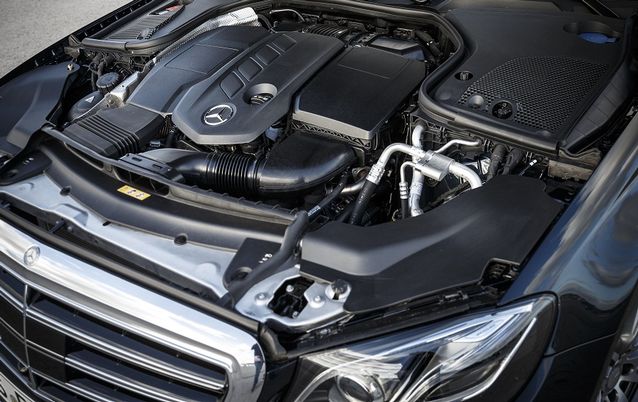
Mercedes will roll out its next generation engines starting with the E220d. Picture: DAIMLER AG
-
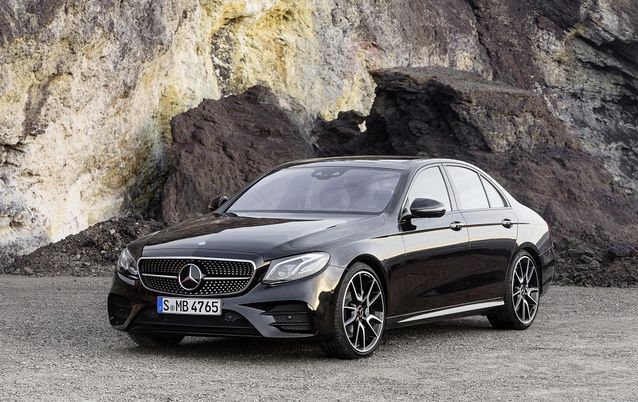
Testing the Active Brake Assist system. Picture: DAIMLER AG
-
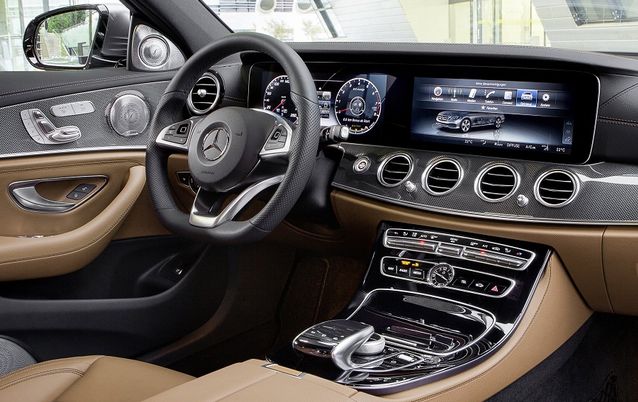
The new E-Class uses digital screens and a smartphone style swipe button on the steering wheel to switch between menus. Picture: DAIMLER AG
-
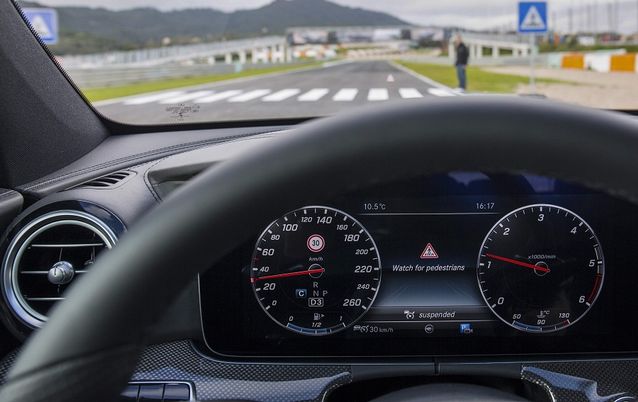
The system warns of pedestrians and can initiate action. Picture: DAIMLER AG
AS YOU will have read in last week’s international drive of the new Mercedes-Benz E-Class, the executive saloon has truly raised the bar in the segment, particularly when it comes to technology.
From the optional 12.3-inch TFT screens for the instrument cluster and infotainment screen to the alphabet soup of safety equipment, there is a great deal to talk about.
At the touch of a button on the steering wheel one can easily switch layouts on the instrument cluster with thumb swipes, as you would on your smartphone, and scroll through a series of menus. In addition, there is LED ambient lighting with 64 colours to choose from, so the cabin lighting can be varied depending on the driver’s mood.
Still on LED lighting, the optional LED headlights comprise 84 individual diodes, offering exceptional lighting of the road ahead.
While the Matrix system, which gives the ability to drive in high beam without dazzling oncoming traffic, is nothing new and something we have experienced in some Audi products, the system in the Merc has been upgraded to take into consideration inclement weather, too. The beam will extend its range by up to six metres more than in clear weather conditions. It also highlights road signs and road verges better, making night driving easier and increasing safety.
There is an array of safety systems including Active Brake Assist with cross-traffic function, which compared with the standard version offers extended speed thresholds with regard to vehicles and pedestrians. It can detect crossing traffic at junctions and, if the driver fails to respond, apply the brakes autonomously. It can also detect hazardous situations at the tail-end of traffic jams where there is no room to manoeuvre and initiate autonomous braking sooner in such situations. It is claimed to be possible to avoid accidents completely at speeds up to 100km/h or substantially reduce the severity of crashes at speeds above this level.
Another interesting safety item is the Evasive Steering Assist, which complements the pedestrian detection function of Active Brake Assist. If the driver initiates an evasive manoeuvre in a hazardous situation, this function can add precisely calculated steering torque to support the movement of the steering wheel. This helps the driver to avoid a pedestrian in a controlled manner while subsequently facilitating the straightening-up of the vehicle to allow the situation to be negotiated safely.
Also impressive was the Traffic Sign Assist, which reads signs such as No Entry, and warns the driver not to travel the wrong way down a one-way street.
There are also functions of the vehicle that are app-based and run off one’s smartphone. These include unlocking the vehicle via your smartphone by placing the phone on the door handle. There is also a Remote Parking Pilot function, similar to that in the new BMW 7 Series, that works off a phone app that allows you to park the vehicle alley dock style into tight spots.
The optional multichamber air suspension gives the E-Class a sophisticated ride quality, perhaps even better than the S-Class. This was evident even on the AMG Line equipped vehicles, which come with 15mm lower suspension but were surprisingly comfortable.
Then there are the engines. Mercedes has defied speculation of a crisis for passenger car diesel engines by unveiling its all-new engine range for the new generation of the E-Class.
The all-new OM 654 engine series will be the first all-aluminium turbodiesel to come from Merc and will be one of the key tools for the brand in meeting its 95g CO2 limit, scheduled to be introduced in Europe in 2020.
It will begin rolling out the new engine family with the E-Class before fitting it to the C-Class and the bottom half of its SUV family.
The modular four-cylinder engine will also become an in-line six-cylinder engine and has the potential to shrink down to become a three-cylinder engine for the A-and B-Class, though Benz refuses to rule out putting the smallest version of the motor into the C-Class.
It is pre-engineered to be used in transverse front-wheel drive, longitudinal rear-wheel drive and all-wheel drive applications, and is adaptable to fit with mild hybrid and plug-in hybrid powertrains. It will arrive first in the E220d. The new powertrain, which replaces the 2.15l OM 651 diesel, pulls the capacity down to a neat 2.0l, shrinking its external dimensions as well while lowering fuel consumption by a claimed 13%.
It’s also a far lighter motor than the outgoing engine, lowering the mass from 202.8kg to 168.4kg, which should deliver better handling and balance. Its power has risen in E220d form from 125kW to 143kW, thanks to the adoption of some technology Mercedes had been reserving for its performance models.
"The new family of engines embodies more than 80 years of Mercedes-Benz diesel know-how," Daimler’s board member for research and development, Thomas Weber, says. "The new premium diesels are more efficient and powerful, lighter and more compact, and they are designed to meet all future global emissions standards. In our opinion, the diesel engine is indispensable in trucks and cars if we want to further reduce the CO2 emissions from traffic."
It uses the same Nanoslide cylinder bore technology as the Mercedes-AMG Formula 1 car, which came from its performance sedans originally. It couples this spray-on hard, smooth cylinder lining with new steel pistons and stepped combustion bowls, along with the fourth-generation of Benz’s common-rail fuel injection system.
Along with lifting power to 143kW at 3,800r/min, the E220d’s new motor brings 400Nm of torque, peaking from 1,600-2,400r/min and delivering a specific output of 72kW/l.
The E-Class is unequivocally the most advanced vehicle in its class, and the high levels of technological features make it a sophisticated and well-polished product in the segment.








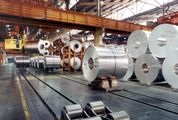















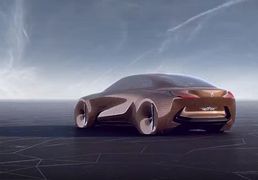

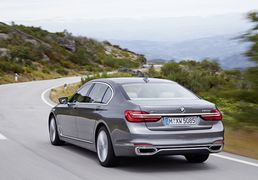





Change: 1.19%
Change: 1.36%
Change: 2.19%
Change: 1.49%
Change: -0.77%
Data supplied by Profile Data
Change: -0.19%
Change: 0.69%
Change: 1.19%
Change: 0.00%
Change: 0.44%
Data supplied by Profile Data
Change: 0.62%
Change: 0.61%
Change: 0.23%
Change: 0.52%
Change: 0.12%
Data supplied by Profile Data
Change: -0.21%
Change: -1.22%
Change: -0.69%
Change: -0.51%
Change: 0.07%
Data supplied by Profile Data